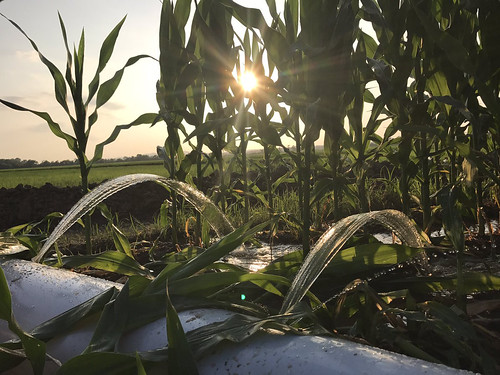YEAREND: Despite cool, wet start, corn ties 4th-highest yield, grain sorghum hits average
Dec. 14, 2018
By Fred Miller
U of A System Division of Agriculture
@AgNews479
Fast Facts:
- Cool, wet weather at planting caused variability in corn, grain sorghum stands
- Corn ties 4th-highest average yield at 181 bushels per acre
- Grain sorghum yields fall within recent averages
(681 words)
(Newsrooms: With file photo https://flic.kr/p/VS4mvH )
Download Word version
FAYETTEVILLE, Ark. — After a slow start because of weather, Arkansas’ corn crop tied
its fourth-highest state average yield and grain sorghum crop yields are within the
normal average range for recent years, said Jason Kelley, extension agronomist for
wheat and feed grains.
Corn and grain sorghum growers faced cool temperatures and heavy rainfall during the planting months of March and April, said Kelley, who works for the University of Arkansas System Division of Agriculture.

“The crop stand at emergence is important,” he said, “and we saw a lot of variability in the stands — not the kind you want to see for good yields.
“Then the weather turned hot and dry in May, and corn farmers had to irrigate,” Kelley said.
Wet weather returned at harvest time, Kelley said, delaying harvests about a month. “It dragged on a lot longer than most farmers wanted,” he said.
Corn
Despite the soggy start, corn yields are projected to average 181 bushels per acre in 2018, according to the U.S. Department of Agriculture’s National Agricultural Statistics Service, down from 183 bushels per acre in 2017, but tying the fourth-place yield seen in 2015.
The highest yield in Arkansas was 187 bushels per acre in 2014, which was up slightly from the second-highest yield of 186 bushels per acre in 2013.
“The highest state average corn yields have all been in the last seven years,” Kelley said.
“That’s a function of good management and taking advantage of favorable weather during the growing season.”
Farmers are currently getting $3.92 per bushel at Memphis, Tenn., Kelley said, 28 cents above the average of $3.64 per bushel for the 2017 crop.
Arkansas farmers planted 660,000 acres of corn in 2018, according to NASS. That’s up 40,000 from 2017. As of the most recent NASS report, 650,000 acres of corn were harvested in 2018, totaling 117,650,000 bushels of corn.
Grain sorghum
NASS estimates grain sorghum yields will average 80 bushels per acre in 2018, up from 76 bushels per acre in 2017.
Kelley said Arkansas farmers are currently able to get $3.24 per bushel for grain sorghum at Memphis, an improvement over $2.80 per bushel NASS reports for the average price Arkansas growers received in 2017. “But the price is drastically lower than just a few years ago when China was buying large amounts of grain sorghum,” he said.
Arkansans planted 12,000 acres of grain sorghum in 2018, up from 9,000 acres last year. NASS reports 10,000 acres of grain sorghum harvested for a total crop so far of 800,000 bushels.
“Grain sorghum acres have been up and down with the markets,” Kelley said.
The highest number of grain sorghum acres in the last 15 years was 450,000 acres in 2015, Kelley said. The crop earned a premium price that year, and Arkansas producers responded by planting large acreages.
The grain sorghum acreage in 2017 and 2018 represents the lowest acreage in the state since prior to 1960. Acreage has dropped drastically the last two years as grain prices have fallen considerably compared to 2015, reducing the overall profitability of grain sorghum. The sugarcane aphid, a new insect pest of grain sorghum, has increased production costs, and also reducing profit potential of grain sorghum.
Grain sorghum has some positives, as it is a good rotation crop for soybeans or cotton. In ongoing research, soybean yields were typically 10 percent higher when planted following grain sorghum than soybeans grown after soybeans, Kelley said.
LOOKING AHEAD
If 2018 has a lesson for 2019, Kelley said, it’s to be selective with the planting date on corn.
“Early planting has lots of advantages most years, but getting an adequate stand is key,” Kelley said.
Kelley said it’s not important to have the first corn or grain sorghum crop in the ground.
“You don’t have to be the earliest one to plant,” Kelley said. “I saw several corn fields that were planted in May that had better yields than March planted corn, simply because of better stands from the May planting.”
To learn about extension programs or agriculture in Arkansas, contact your local Cooperative Extension Service agent or visit www.uaex.uada.edu. Follow us on Twitter at @AR_Extension.
About the Division of Agriculture
The University of Arkansas System Division of Agriculture’s mission is to strengthen agriculture, communities, and families by connecting trusted research to the adoption of best practices. Through the Agricultural Experiment Station and the Cooperative Extension Service, the Division of Agriculture conducts research and extension work within the nation’s historic land grant education system.
The Division of Agriculture is one of 20 entities within the University of Arkansas System. It has offices in all 75 counties in Arkansas and faculty on five system campuses.
Pursuant to 7 CFR § 15.3, the University of Arkansas System Division of Agriculture offers all its Extension and Research programs and services (including employment) without regard to race, color, sex, national origin, religion, age, disability, marital or veteran status, genetic information, sexual preference, pregnancy or any other legally protected status, and is an equal opportunity institution.
# # #
Media Contact: Mary Hightower
Dir. of Communication Services
U of A System Division of Agriculture
Cooperative Extension Service
(501) 671-2126
mhightower@uada.edu
Related Links